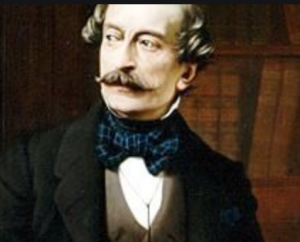Biography

D’AZEGLIO Massimo, painter and writer (Turin 1798 – 1866). Of an aristocratic Piedmontese family loyal to the Savoy House, he spent part of his childhood in Florence where his parents had moved following the French occupation.
In 1814, his father, Marquis C. Taparelli d’Azeglio, appointed minister to Pope Pius VII followed in Rome. The Roman stay influenced his artistic training; on the one hand the Flemish painter Martin Verstappen directs him to the picturesque views and costume scenes, on the other his romantic soul leads him to practice painting in real life during the long walks undertaken between the suggestive landscapes of the Roman countryside, then decidedly wild.
Strong stimuli also come from the international environment present in the capital, from contacts with the likes of Vincenzo Camuccini, Bertel Thorvaldsen, Nicolas Didier Boguet, Francois Marius Granet, Jacob Philipp Hackert. And Johann Christian Reinhart.
In 1820 he sent two landscapes to the Turin Exhibition. Of the Roman period and of the study trip made to Naples that same year, evidence remains in landscape studies, where attention to light variations and suggestive effects are indications of an already romantic sensitivity.
In the following years the landscape went into the background, almost as a backdrop to the romance episodes that arose from his literary pen, as evidenced by his first demanding work of 1825, The death of Montmorency (Gallery of Modern Art in Turin), with which the thematic strand of the Crusades is inaugurated.
In 1831 he moved to Milan where he attended the romantic cenacle gathered around Alessandro Manzoni, whose daughter Giulia he married. The elaboration of historical subjects commits him both as a writer and as a painter and engraver: for Ettore Fieramosca or La Disfida di Barletta, he first completes a painting, exhibited in Brera in 1831, and then realizes the engravings that illustrate the novel, given to the prints in 1833. From that year he began a regular participation in the Brera exhibitions which lasted until 1843 and resumed after the political commitments that diverted him from painting until 1852.
During this same period he also participates assiduously in the exhibitions held in Turin. In 1836 he was present with three works at the Paris Salon and in 1837 he was commissioned by the Savoy to make six historical-celebratory paintings on the glorious events of the Savoy house (three of the series are still found today in the Royal Palace of Turin), in which one can find stylistic elements of 17th century Dutch landscape painting.
In later landscape subjects, finally free from literary concerns, there is a greater spontaneity and a search for light that bring him closer to the works of contemporary Swiss painters (see for example: Sunset effect on Monte Cenere, Turin, Art Gallery Modern).
He died in the villa of Cannero on Lake Maggiore, while he was still working on the autobiographical book: I miei ricordi.